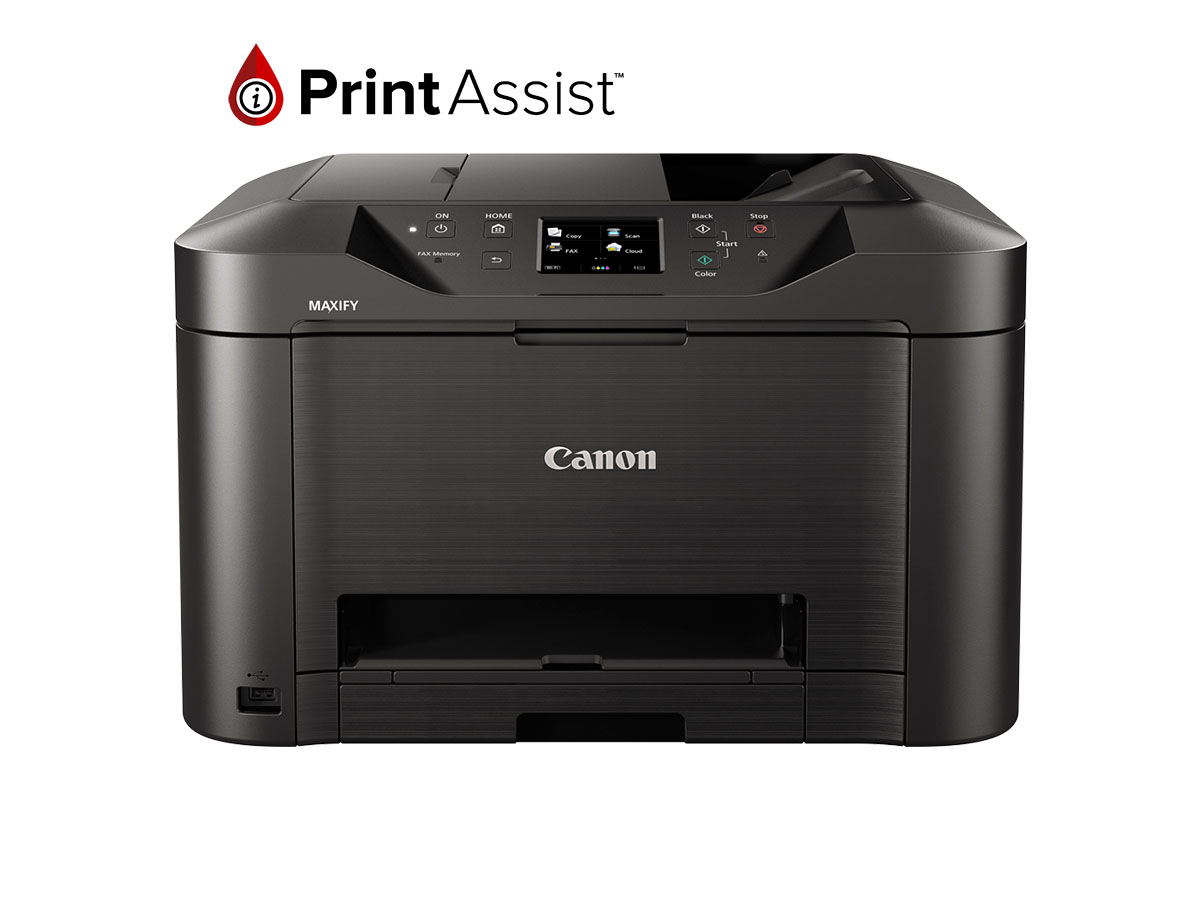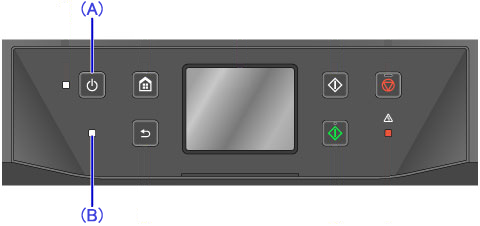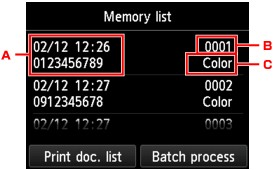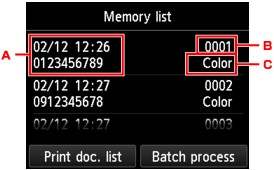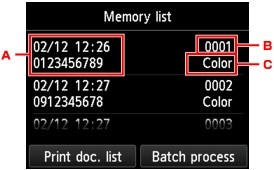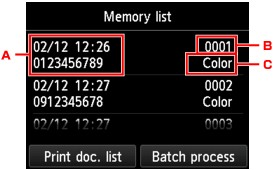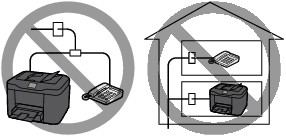Issue
Cause and solution
Cause and solution
[ Cannot Send a Fax ]
[ Cannot Send a Fax ]
Cause and solution
Check 1: Is the power turned on?
(A) ON button
(B) FAX Memory lamp
Caution
If a power failure occurs or you unplug the power cord, all faxes stored in the machine's memory are deleted.
Caution
Cause and solution
Check 2: Is the document being sent from memory or the fax being received into memory?
When the message for the transmission/reception is displayed on the Fax standby screen, a fax is being sent from/received into machine's memory. Wait until the transmission/reception is complete.
If the sending faxes is not complete or the machine was not able to print the received faxes, these faxes are stored in the machine's memory.
If an error occurred during a fax transmission, the document is not stored in the machine's memory.
In the following cases, the machine is not able to print the received fax and will automatically store the fax in its memory.
Caution
You can print or delete the faxes stored in the machine's memory. You can also save the received faxes stored in the machine's memory on the USB flash drive or forward the received faxes stored in the machine's memory to the shared folder on the computer.
-⋗ See [ Printing a Document in Machine's Memory ] in this page.
-⋗ See [ Deleting a Document in Machine's Memory ] in this page.
-⋗ See [ Saving a Document in Machine's Memory to USB Flash Drive ] in this page.
-⋗ See [ Forwarding a Document in Machine's Memory to Shared Folder on the Computer ] in this page.
Caution
When confirming, printing, or deleting a document stored in the machine's memory, you specify it by its transaction number. If you do not know the transaction number for your target document, print the list of documents (MEMORY LIST) first.
For details on how to print MEMORY LIST, see [ Printing a Document in Machine's Memory ] in this page.
Printing a Document in Machine's Memory
You can print a specified document in the machine's memory or print all the documents in its memory at a time.
When printing a specified document, you specify it by its transaction number. If you do not know the transaction number for your target document, print the list of documents (MEMORY LIST) first.
1. Make sure that the machine is turned on.
2. Load paper.
3. Flick the HOME screen, then tap 
The Fax standby screen is displayed.
4. Tap Function list.
The Function list screen is displayed.
5. Tap Memory reference.
The memory list is displayed.
A. Date and time of transaction and fax/telephone number
B. Transaction number (TX/RX NO.)
A transaction number from "0001" to "4999" indicates a document being sent.
A transaction number from "5001" to "9999" indicates a document being received.
C. Color information
Color is displayed for color transmission/reception. Nothing is displayed for black & white transmission/reception.
Caution
6. Select a print menu.
You can print a list of the documents in the machine's memory by tapping Print doc. list.
When the print confirmation screen is displayed, tap Yes. The printing starts.
MEMORY LIST shows the transaction number of the unsent or unprinted fax (TX/RX NO.), transaction mode, recipient's number, and the date and time of the transaction.
A transaction number from "0001" to "4999" on MEMORY LIST indicates a document being sent. A transaction number from "5001" to "9999" on MEMORY LIST indicates a document being received.
Select a document to print on the Memory list screen, tap Print specified document.
Caution
The confirmation screen to select whether to print only the first page of the document is displayed.
If you select Yes, only the first page of the document will be printed. The document is still stored in the machine's memory.
If you select No, all pages of the document will be printed. The screen to confirm whether to delete the printed document in the machine's memory is displayed after printing.
Tap Batch process then tap Print all RX documents.
When the print confirmation screen is displayed, tap Yes. All the documents in the machine's memory are printed.
Each time a document is printed, the screen to confirm whether to delete the printed document in the machine's memory is displayed.
If you tap Yes, the printed document in the machine's memory is deleted.
Deleting a Document in Machine's Memory
You can delete a specified document in the machine's memory or delete all the documents in its memory at a time.
Caution
When deleting a specified document, you specify it by its transaction number. If you do not know the transaction number for your target document, print the list of documents (MEMORY LIST) first.
-⋗ See [ Printing a Document in Machine's Memory ] in this page.
1. Make sure that the machine is turned on.
2. Flick the HOME screen, then tap 
The Fax standby screen is displayed.
3. Tap Function list.
The Function list screen is displayed.
4. Tap Memory reference.
The memory list is displayed.
A. Date and time of transaction and fax/telephone number
B. Transaction number (TX/RX NO.)
A transaction number from "0001" to "4999" indicates a document being sent.
A transaction number from "5001" to "9999" indicates a document being received.
C. Color information
Color is displayed for color transmission/reception. Nothing is displayed for black & white transmission/reception.
Caution
If no document is stored in the machine's memory, There is no document in memory. is displayed. Tap OK to return to the previous screen.
5. Select a delete menu.
Select a document to delete on the Memory list screen, tap Delete specified doc..
Caution
The confirmation screen is displayed.
If you select Yes, the specified document is deleted from machine's memory.
Tap Batch process then tap Delete all documents.
The confirmation screen is displayed.
If you select Yes, all documents are deleted from machine's memory.
Saving a Document in Machine's Memory to USB Flash Drive
You can save the received faxes stored in the machine's memory to the USB flash drive as PDF files using the operation panel of the machine.
You can save a specified document in the machine's memory to the USB flash drive or save all the documents in its memory to the USB flash drive at a time.
Caution
Caution
-⋗ See [ Printing a Document in Machine's Memory ] in this page.
For details on how to delete the fax in the machine's memory, see [ Deleting a Document in Machine's Memory ] in this page.
1. Make sure that the machine is turned on.
2. Insert the USB flash drive into the USB flash drive port.
3. Flick the HOME screen, then tap 
The Fax standby screen is displayed.
4. Tap Function list.
The Function list screen is displayed.
5. Tap Memory reference.
The memory list is displayed.
A.Date and time of transaction and fax/telephone number
B.Transaction number (TX/RX NO.)
A transaction number from "0001" to "4999" indicates a document being sent.
A transaction number from "5001" to "9999" indicates a document being received.
C.Color information
Color is displayed for color transmission/reception. Nothing is displayed for black & white transmission/reception.
Caution
If no document is stored in the machine's memory, There is no document in memory. is displayed. Tap OK to return to the previous screen.
6. Select a save menu.
Select a document to save on the Memory list screen, tap Save specified document.
Caution
Tap USB flash drive as the destination. The specified document is saved on the USB flash drive.
Tap Batch process then tap Save all RX documents.
Tap USB flash drive as the destination. All documents are saved on the USB flash drive.
Caution
- Folder name: CANON_SC\FAXDOC\0001
- File name (file extension: PDF): Running numbers, starting from FAX_0001
- File date: The date and time of saving as set in the machine.
-⋗ See [ Setting the Date and Time ] in this page.
Forwarding a Document in Machine's Memory to Shared Folder on the Computer
You can forward the received faxes stored in the machine's memory to the shared folder on the computer as PDF files using the operation panel of the machine.
You can forward a specified document in the machine's memory to the shared folder on the computer or forward all the documents in its memory to the shared folder on the computer at a time.
Caution
Caution
-⋗ See [ Printing a Document in Machine's Memory ] in this page.
For details on how to delete the fax in the machine's memory, see [ Deleting a Document in Machine's Memory ] in this page.
1. Make sure that the machine is turned on.
2. Make sure that the machine is connected with the destination computer.
3. Flick the HOME screen, then tap 
The Fax standby screen is displayed.
4. Tap Function list.
The Function list screen is displayed.
5. Tap Memory reference.
The memory list is displayed.
A. Date and time of transaction and fax/telephone number
B. Transaction number (TX/RX NO.)
A transaction number from "0001" to "4999" indicates a document being sent.
A transaction number from "5001" to "9999" indicates a document being received.
C. Color information
Color is displayed for color transmission/reception. Nothing is displayed for black & white transmission/reception.
Caution
6. Select a forward menu.
Select a document to forward on the Memory list screen, tap Save specified document.
Caution
Tap Destination folder as the destination.
Tap a destination folder to forward the specified document to the shared folder on the computer.
Caution
Tap Batch process then tap Save all RX documents.
Tap Destination folder as the destination.
Tap a destination folder to forward all documents to the shared folder on the computer.
Caution
Caution
Cause and solution
Check 3: Is the machine's memory full?
Delete contents in memory, then send a fax again.
If the sending faxes is not complete or the machine was not able to print the received faxes, these faxes are stored in the machine's memory.
If an error occurred during a fax transmission, the document is not stored in the machine's memory.
In the following cases, the machine is not able to print the received fax and will automatically store the fax in its memory.
Caution
You can print or delete the faxes stored in the machine's memory. You can also save the received faxes stored in the machine's memory on the USB flash drive or forward the received faxes stored in the machine's memory to the shared folder on the computer.
-⋗ See [ Printing a Document in Machine's Memory ] in this page.
-⋗ See [ Deleting a Document in Machine's Memory ] in this page.
-⋗ See [ Saving a Document in Machine's Memory to USB Flash Drive ] in this page.
-⋗ See [ Forwarding a Document in Machine's Memory to Shared Folder on the Computer ] in this page.
Caution
When confirming, printing, or deleting a document stored in the machine's memory, you specify it by its transaction number. If you do not know the transaction number for your target document, print the list of documents (MEMORY LIST) first.
For details on how to print MEMORY LIST, see [ Printing a Document in Machine's Memory ] in this page.
Printing a Document in Machine's Memory
You can print a specified document in the machine's memory or print all the documents in its memory at a time.
When printing a specified document, you specify it by its transaction number. If you do not know the transaction number for your target document, print the list of documents (MEMORY LIST) first.
1. Make sure that the machine is turned on.
2. Load paper.
3. Flick the HOME screen, then tap 
The Fax standby screen is displayed.
4. Tap Function list.
The Function list screen is displayed.
5. Tap Memory reference.
The memory list is displayed.
A. Date and time of transaction and fax/telephone number
B. Transaction number (TX/RX NO.)
A transaction number from "0001" to "4999" indicates a document being sent.
A transaction number from "5001" to "9999" indicates a document being received.
C. Color information
Color is displayed for color transmission/reception. Nothing is displayed for black & white transmission/reception.
Caution
6. Select a print menu.
You can print a list of the documents in the machine's memory by tapping Print doc. list.
When the print confirmation screen is displayed, tap Yes. The printing starts.
MEMORY LIST shows the transaction number of the unsent or unprinted fax (TX/RX NO.), transaction mode, recipient's number, and the date and time of the transaction.
A transaction number from "0001" to "4999" on MEMORY LIST indicates a document being sent. A transaction number from "5001" to "9999" on MEMORY LIST indicates a document being received.
Select a document to print on the Memory list screen, tap Print specified document.
Caution
The confirmation screen to select whether to print only the first page of the document is displayed.
If you select Yes, only the first page of the document will be printed. The document is still stored in the machine's memory.
If you select No, all pages of the document will be printed. The screen to confirm whether to delete the printed document in the machine's memory is displayed after printing.
Tap Batch process then tap Print all RX documents.
When the print confirmation screen is displayed, tap Yes. All the documents in the machine's memory are printed.
Each time a document is printed, the screen to confirm whether to delete the printed document in the machine's memory is displayed.
If you tap Yes, the printed document in the machine's memory is deleted.
Deleting a Document in Machine's Memory
You can delete a specified document in the machine's memory or delete all the documents in its memory at a time.
Caution
When deleting a specified document, you specify it by its transaction number. If you do not know the transaction number for your target document, print the list of documents (MEMORY LIST) first.
-⋗ See [ Printing a Document in Machine's Memory ] in this page.
1. Make sure that the machine is turned on.
2. Flick the HOME screen, then tap 
The Fax standby screen is displayed.
3. Tap Function list.
The Function list screen is displayed.
4. Tap Memory reference.
The memory list is displayed.
A. Date and time of transaction and fax/telephone number
B. Transaction number (TX/RX NO.)
A transaction number from "0001" to "4999" indicates a document being sent.
A transaction number from "5001" to "9999" indicates a document being received.
C. Color information
Color is displayed for color transmission/reception. Nothing is displayed for black & white transmission/reception.
Caution
If no document is stored in the machine's memory, There is no document in memory. is displayed. Tap OK to return to the previous screen.
5. Select a delete menu.
Select a document to delete on the Memory list screen, tap Delete specified doc..
Caution
The confirmation screen is displayed.
If you select Yes, the specified document is deleted from machine's memory.
Tap Batch process then tap Delete all documents.
The confirmation screen is displayed.
If you select Yes, all documents are deleted from machine's memory.
Saving a Document in Machine's Memory to USB Flash Drive
You can save the received faxes stored in the machine's memory to the USB flash drive as PDF files using the operation panel of the machine.
You can save a specified document in the machine's memory to the USB flash drive or save all the documents in its memory to the USB flash drive at a time.
Caution
Caution
-⋗ See [ Printing a Document in Machine's Memory ] in this page.
For details on how to delete the fax in the machine's memory, see [ Deleting a Document in Machine's Memory ] in this page.
1. Make sure that the machine is turned on.
2. Insert the USB flash drive into the USB flash drive port.
3. Flick the HOME screen, then tap 
The Fax standby screen is displayed.
4. Tap Function list.
The Function list screen is displayed.
5. Tap Memory reference.
The memory list is displayed.
A.Date and time of transaction and fax/telephone number
B.Transaction number (TX/RX NO.)
A transaction number from "0001" to "4999" indicates a document being sent.
A transaction number from "5001" to "9999" indicates a document being received.
C.Color information
Color is displayed for color transmission/reception. Nothing is displayed for black & white transmission/reception.
Caution
If no document is stored in the machine's memory, There is no document in memory. is displayed. Tap OK to return to the previous screen.
6. Select a save menu.
Select a document to save on the Memory list screen, tap Save specified document.
Caution
Tap USB flash drive as the destination. The specified document is saved on the USB flash drive.
Tap Batch process then tap Save all RX documents.
Tap USB flash drive as the destination. All documents are saved on the USB flash drive.
Caution
- Folder name: CANON_SC\FAXDOC\0001
- File name (file extension: PDF): Running numbers, starting from FAX_0001
- File date: The date and time of saving as set in the machine.
-⋗ See [ Setting the Date and Time ] in this page.
Forwarding a Document in Machine's Memory to Shared Folder on the Computer
You can forward the received faxes stored in the machine's memory to the shared folder on the computer as PDF files using the operation panel of the machine.
You can forward a specified document in the machine's memory to the shared folder on the computer or forward all the documents in its memory to the shared folder on the computer at a time.
Caution
Caution
-⋗ See [ Printing a Document in Machine's Memory ] in this page.
For details on how to delete the fax in the machine's memory, see [ Deleting a Document in Machine's Memory ] in this page.
1. Make sure that the machine is turned on.
2. Make sure that the machine is connected with the destination computer.
3. Flick the HOME screen, then tap 
The Fax standby screen is displayed.
4. Tap Function list.
The Function list screen is displayed.
5. Tap Memory reference.
The memory list is displayed.
A. Date and time of transaction and fax/telephone number
B. Transaction number (TX/RX NO.)
A transaction number from "0001" to "4999" indicates a document being sent.
A transaction number from "5001" to "9999" indicates a document being received.
C. Color information
Color is displayed for color transmission/reception. Nothing is displayed for black & white transmission/reception.
Caution
6. Select a forward menu.
Select a document to forward on the Memory list screen, tap Save specified document.
Caution
Tap Destination folder as the destination.
Tap a destination folder to forward the specified document to the shared folder on the computer.
Caution
Tap Batch process then tap Save all RX documents.
Tap Destination folder as the destination.
Tap a destination folder to forward all documents to the shared folder on the computer.
Caution
Caution
Cause and solution
Check 4: Is the telephone line type set correctly?
Check the telephone line type setting and change it as necessary.
The connection method differs depending on your telephone line.
-⋗ See [ Basic Connection ] in this page.
-⋗ See [ Connecting Various Lines ] in this page.
If the connection is incorrect, the machine cannot send/receive faxes. Connect the machine correctly.
Caution
Do not connect fax machines and/or telephones in parallel (US and Canada only).
If two or more fax machines and/or telephones are connected in parallel, the following problems may occur and the machine may not operate properly.
If you cannot avoid parallel connections, set the receive mode to TEL priority mode, understanding that the above problems may occur. You will only be able to receive faxes manually.
Basic Connection
Make sure that the machine is turned off, connect one end of supplied telephone line cable to the telephone line jack near the "LINE" mark of the machine, then connect the other end to the telephone line jack on the wall or to the telephone line jack of the xDSL splitter.
When you connect the telephone to the machine, make sure that the machine is turned off, connect one end of the modular cable to the external device jack near the "EXT." mark of the machine, then connect the other end to the telephone line jack of the telephone.
Caution
If you connect the telephone line when the machine is turned on, turn the machine off and unplug the power cord. Wait for 1 minute then connect the telephone line and power plug.
Caution
If the connector of the external device cannot be connected to the jack on the machine, you will need to purchase a B.T. adapter to connect as follows:
Attach the B.T. adapter to the modular cable connecting the external device, then connect the B.T. adapter to the external device jack.
Connecting Various Lines
This section introduces how to connect various lines.
These are examples and could not be guaranteed to suit every connecting condition. For details, refer to the instruction manual supplied with the network device (control devices such as an xDSL (Digital Subscriber Line) modem or terminal adapter) you are connecting to this machine.
Caution
A.Digital Subscriber Line
B.xDSL modem (splitter may not be built-in to the modem)
C.Broadband router compatible with Internet Telephone
D.Computer
E.Telephone or answering machine
F.WAN (Wide Area Network) port
G.LAN (Local Area Network) port
H.TEL port
I.LINE port
* Port configurations and names may vary depending on the product.
Caution
A.Analog Subscriber Line
B.xDSL modem (splitter may not be built-in to the modem)
C.Computer
D.Telephone or answering machine
Caution
Caution
For details on ISDN (Integrated Service Digital Network) connection and settings, refer to the manuals supplied with your terminal adapter or dial-up router.
Cause and solution
Check 5: Is Hook key setting set to Disable?
When you send a fax manually, dial the number with [ Enable ] selected for [ Hook key setting ] in [ Security control ] under [ FAX settings ], or dial the number using the telephone connected to the machine.
Cause and solution
Check 6: Is Dial tone detect set to ON?
Resend the fax after a while.
If you still cannot send the fax, select [ OFF ] for [ Dial tone detect ] in [ Advanced FAX settings ] under [ FAX settings ].
Cause and solution
Check 7: Is the fax number registered correctly in the machine's directory?
Check the recipient's fax/telephone number, correct the fax/telephone number registered in the machine's directory, then send the document again.
Caution
Cause and solution
Check 8: Does an error occur during transmission?
-⋗ [ A Message for Faxing Is Displayed on the LCD ]
Cause and solution
Check 9: Is the document loaded properly?
Remove the document, then reload it on the Platen Glass or in the ADF.
Cause and solution
Check 10: Does a printer error occur?
Ensure that an error message is displayed on the touch screen. When an error message is displayed on the touch screen, check the cause.
-⋗ [ A Support Code Is Displayed ]
If you are in a hurry, press the Stop button to close the message, then send the fax.
Cause and solution
Check 11: Is the telephone line connected correctly?
Reconnect the telephone line cable to the telephone line jack.
If the telephone line is connected correctly, there is a problem with your telephone line. Contact your telephone company and the manufacturer of your terminal adapter or telephone adapter.
The connection method differs depending on your telephone line.
-⋗ See [ Basic Connection ] in this page.
-⋗ See [ Connecting Various Lines ] in this page.
If the connection is incorrect, the machine cannot send/receive faxes. Connect the machine correctly.
Caution
Do not connect fax machines and/or telephones in parallel (US and Canada only).
If two or more fax machines and/or telephones are connected in parallel, the following problems may occur and the machine may not operate properly.
If you cannot avoid parallel connections, set the receive mode to TEL priority mode, understanding that the above problems may occur. You will only be able to receive faxes manually.
Basic Connection
Make sure that the machine is turned off, connect one end of supplied telephone line cable to the telephone line jack near the "LINE" mark of the machine, then connect the other end to the telephone line jack on the wall or to the telephone line jack of the xDSL splitter.
When you connect the telephone to the machine, make sure that the machine is turned off, connect one end of the modular cable to the external device jack near the "EXT." mark of the machine, then connect the other end to the telephone line jack of the telephone.
Caution
If you connect the telephone line when the machine is turned on, turn the machine off and unplug the power cord. Wait for 1 minute then connect the telephone line and power plug.
Caution
If the connector of the external device cannot be connected to the jack on the machine, you will need to purchase a B.T. adapter to connect as follows:
Attach the B.T. adapter to the modular cable connecting the external device, then connect the B.T. adapter to the external device jack.
Connecting Various Lines
This section introduces how to connect various lines.
These are examples and could not be guaranteed to suit every connecting condition. For details, refer to the instruction manual supplied with the network device (control devices such as an xDSL (Digital Subscriber Line) modem or terminal adapter) you are connecting to this machine.
Caution
A.Digital Subscriber Line
B.xDSL modem (splitter may not be built-in to the modem)
C.Broadband router compatible with Internet Telephone
D.Computer
E.Telephone or answering machine
F.WAN (Wide Area Network) port
G.LAN (Local Area Network) port
H.TEL port
I.LINE port
* Port configurations and names may vary depending on the product.
Caution
A.Analog Subscriber Line
B.xDSL modem (splitter may not be built-in to the modem)
C.Computer
D.Telephone or answering machine
Caution
Caution
For details on ISDN (Integrated Service Digital Network) connection and settings, refer to the manuals supplied with your terminal adapter or dial-up router.
Cause and solution
Cause and solution
[ Cannot Perform Sequential Broadcasting by Redialing, or Cannot Dial by Entering the Numbers ]
[ Cannot Perform Sequential Broadcasting by Redialing, or Cannot Dial by Entering the Numbers ]
Cause and solution
Check: Have you already selected the recipient from the redial history, or already dialed a number by entering the fax/telephone numbers?
You can dial one recipient by selecting from the redial history or by entering the fax/telephone numbers as the recipient of sequential broadcasting.
If you already have dialed by selecting from the redial history or by entering the fax/telephone numbers, select the recipient from the machine's directory.
Cause and solution
Cause and solution
[ Errors Often Occur When You Send a Fax ]
[ Errors Often Occur When You Send a Fax ]
Cause and solution
Check: Check the telephone line condition or the connection.
If the telephone line or connection is poor, reducing the transmission start speed may correct the error.
Reduce the transmission start speed on TX start speed in Adv. communication settings in Advanced FAX settings under FAX settings.







